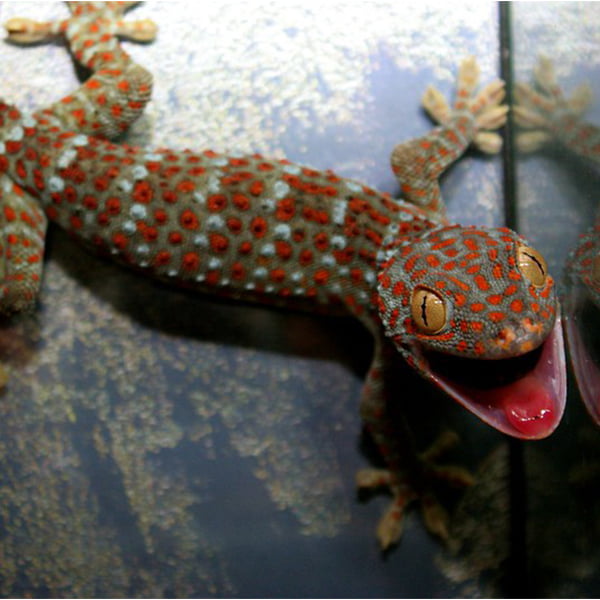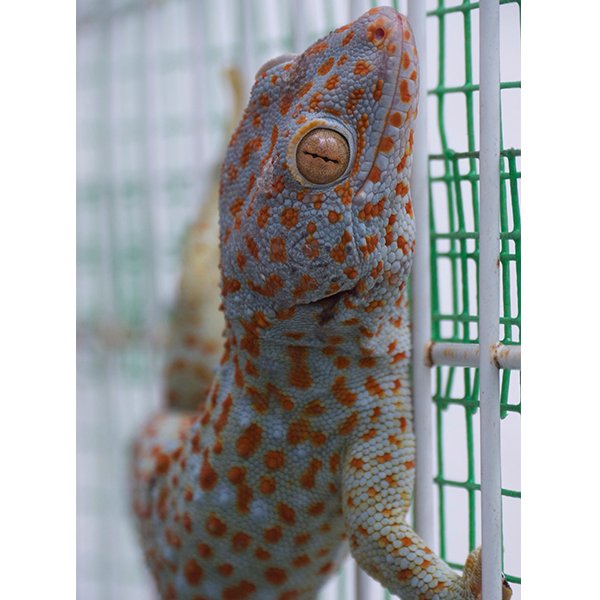Tokay gecko (Gekko gecko) is a beautiful species of reptile that gets its name from the distinct and loud "to-kay" sound they make. And lucky for you, they make a great pet choice for more experienced reptile parents looking for a more challenging pet.
These big reptiles are unsuitable for amateur or new reptile parents since they can be aggressive and loud and are not cuddly or friendly. For reptile enthusiasts happy to care for and have reptiles, they are happy enough to watch more than touch. However, tokay geckos may make a perfect choice.
Name And Origin of Tokay Geckos
Tokay geckos are the second largest type of gecko and originate in Southeast Asia and some of the Pacific islands. These wild animals are arboreal species that spend most of their time on treetops and on cliffs.
Tokay geckos are decreasing in number in the wild due to being poached for supposed medicinal properties, habitat destruction, and the pet trade. They are now considered a threatened species and endangered species in some Countries.
Tokay geckos are a beautiful species but do not make a good choice for beginners since they are known to be a pretty aggressive type and may bite owners who don't know what they are doing.
Choosing A Tokay Gecko
You can find captive-bred tokay geckos from a breeder and animal rescue. If you are going with one of these options, pick a reputable breeder or rescue that can tell you about its origin and health. They should cost anywhere between $20-$50.
The best way to determine whether a tokay gecko is healthy is to pick it up. A healthy tokay gecko will dislike being held and will vocalize or even attempt to bite you, indicating normal and healthy behavior. Be sure your hand is behind its head to avoid getting a bite.
When choosing a Tokay gecko, pick one whose ribs and pelvic bone aren't visible. No bumps on its skin. as this is a sign of an infection or a broken bone.

Source: Flickr
Appearance and Size
Tokay geckos are one of the largest species of geckos. Males measure between 13 and 16 inches, and females are 8 to 12 inches long. These big reptiles come in various vibrant colors, generally having a blue-grey body with brighter orange or blue spots. They have big heads, strong jaws, and prehensile tails, meaning they detach their tails if the gecko feels threatened.
Life Expectancy
Tokay geckos live ten years on average in captivity.
Housing
Due to their large size, tokay geckos need a tank that is a minimum of twenty gallons. The tank should have a very secure lid to ensure that your gecko cannot escape. While you can house more than one tokay gecko in a tank, you should never house more than one male in each tank. Males are very aggressive and territorial. Tokay geckos are solitary creatures, only interacting with other geckos during the breeding season, so it is more than fine to have just one or to give each tokay gecko its own tank.
The tank should be laid with absorbent substrate and filled with study branches to climb on. You can add reptile-safe potted plants or artificial plants to enhance your tokay gecko's environment. Cork bark, half logs, and artificial caves are also a nice addition to provide a place for your gecko to hide or rest.
Behavior & Temperament
Tokay geckos are a nocturnal species, meaning they sleep during the day and eat and are active at night. These geckos are very territorial and have feisty and sometimes aggressive temperaments. They can become less aggressive with regular interaction, but they still are not good pets for lots of handling. They will bite when they feel threatened or stressed, and they often are stubborn about letting go once they have a grip.
Heat & Humidity
Because the tokay gecko species is nocturnal, it is quite important to mimic a normal day/night cycle as closely as possible. Try to keep the tank between 80-90 degrees during the day and between 70-80 degrees at night. Use a heating element that heats from above rather than a heating pad. This prevents your gecko from overheating and allows it to warm itself while climbing. Use an incandescent lightbulb during the day, but at night use a reptile bulb or a ceramic heat element so that the tank can get dark and help maintain your tokay gecko's sleep cycle.
The humidity tokay geckos need in their tank should be around 70% and should never get below 50%. Use a hygrometer to measure humidity levels in the tank. Ensure the tank has some airflow, however, to ensure that the tank doesn't get overly damp or moldy. Mist the substrate and leaves in your tank to maintain the moisture and humidity levels, and always have a shallow bowl of water available.
Light
Tokay geckos do not require a USB emitting bulb since they are nocturnal animals. Some experts say that some UVB may be beneficial, but in general, they will not be necessary. For viewing your gecko at night, you should use a low-light red bulb to avoid disturbing your gecko's day/night schedule. This will allow you to view your pet when it is most active while not interrupting its cycle.
Feeding
Tokay geckos are voracious eaters and will benefit from a large and varied diet. You can feed your tokay gecko feeder insects, grasshoppers, cockroaches, dubia roaches, bloodworms, and super worms.
The feeder insects should be fed nutrient-dense foods that will get passed to your gecko in consumption. This ensures all your gecko's diet needs are met. Insect prey should also be dusted in a vitamin supplement containing calcium before being fed to your pet. Tokay geckos should be fed every 24 hours or once a day, and the amount will depend on your gecko's age and size. As with other gecko species, consult with your exotics vet if you need help determining the appropriate quantity of food for your tokay gecko.
Water
Your tokay gecko will hydrate from the droplets of water on the leaves and branches in his tank that form from misting. This is how geckos get their water on the tops of trees in the wild. You should also provide a shallow dish of water in its tank to have another water source if it needs it.
Substrate
A substrate is a material that lines the bottom of terrarium tanks for reptiles. For tokay geckos, the substrate you use needs to be very good at retaining water so that the tank's humidity can be maintained. Orchid bark and coconut husk substrates are ideal for this. In shedding season, it may be easier to use something more easily cleaned up. Plain, unbleached, un-inked paper towels will make an appropriate substrate while your gecko sheds and will be easier to clean up.
Gender Identification
The easier way to identify the sex of your gecko is by its size and coloring. Male geckos are quite a bit larger than female tokay geckos. Male tokay geckos are also usually brighter in color, whereas females tend to be a bit duller. Males usually have bigger, thicker heads.
To be sure, however, you can always check their undersides, provided they are tame enough. Makes will have a row of pre-anal pores just above their vent line. These tiny raised pores are aligned in a v-shape. Females won't have these pores, or they will be much less prominent.

Source: Flickr
Common Health and Behavior Problems
There are a few common health issues tokay geckos can suffer with.
Mouth Rot
Mouth rot or stomatitis is a condition that is marked by a reddish mouth and cheesy-looking mouth ooze.
Respiratory Infection
This is often the result of imbalanced humidity levels. It is indicated by excess saliva.
Parasitic Infection
Parasitic infection can be internal or external and is marked by a rash, trouble shedding, sluggishness, change in fecal matter, and a change in appetite.
All these conditions are treatable if caught early enough. So be sure to know what to look for and when to take your gecko to the vet.
Aggression
A behavior problem or consideration is how aggressive tokay geckos can be. They are not cuddly pets who are meant to be handled. If they are handled too much or feel threatened or stressed, they could bite you and hold on and not let go.
